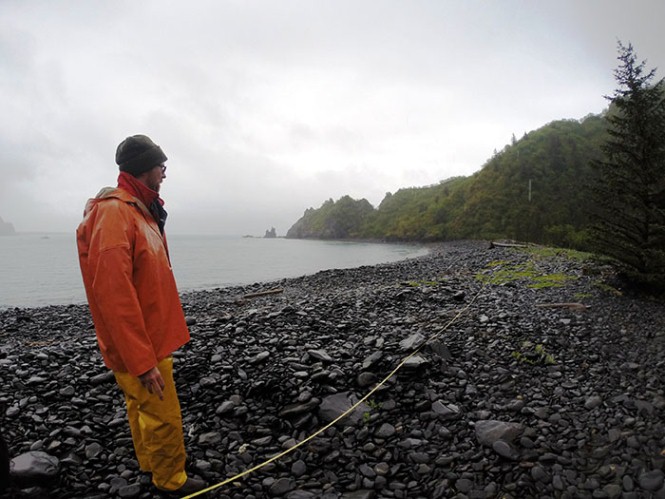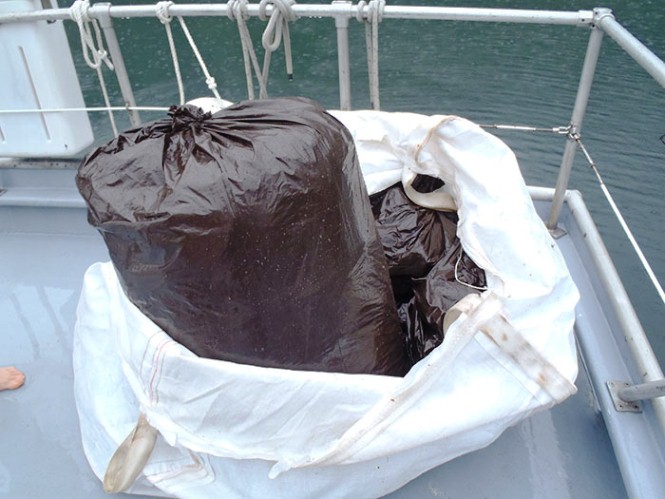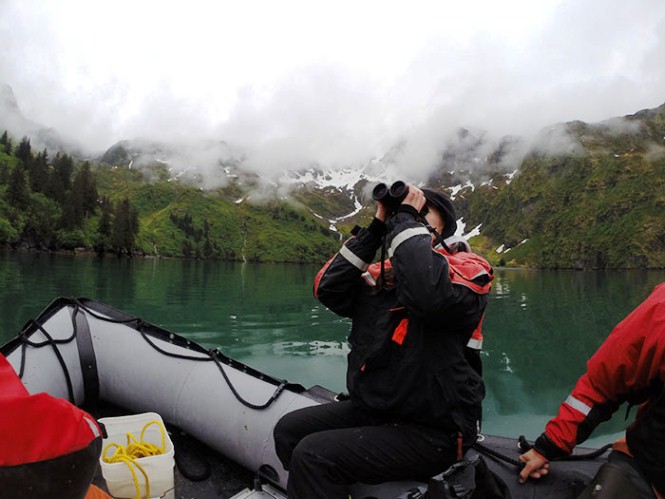
Setting up a marine debris transect at Bulldog Cove.
Photo: NPS / Fiona Ritter
In late May, Kenai Fjords National Park employees embarked on a multi-day journey into the fjords. Our primary mission: to understand the amount and types of marine debris on remote park beaches. We have a NOAA marine debris monitoring plot in each of the three bays closest to Seward—Resurrection, Aialik, and Harris Bays, which we visit annually to document the rate of marine debris accumulation.
Despite steady rain we boarded the Serac, our trusty park boat, and headed south to Bulldog Cove, the first marine debris monitoring beach. After measuring out a 100 meter wide transect, we noted and collected all of the debris below the vegetation line on the beach. Next, we fought our way through thick alders and salmonberry bushes to find every piece of plastic that had blown beyond the vegetation line toward the peaceful lagoon that marked the backside of our transect. After carefully recording each piece of trash we packed it onto the skiff and conducted a COASST seabird mortality survey before heading back to the Serac.

Full bags of marine debris from Bulldog Cove.

Full bags of marine debris from Bulldog Cove.
Photo: NPS / Sharon Kim)
After a winding, slightly pitching crossing around Aialik Cape, we anchored in Crater Bay for the night. The morning brought more rain as we motored into beautiful Northwestern Spit. This remote beach is a moraine left by the glacier that has receded further up the fjord. The protected water was flat calm, making for an easy landing. This time the upper half of the marine debris transect was full of grasses and wildflowers, making it much easier to spot marine debris. After surveying the entire transect, we ended up with only one large garbage bag full - still a surprising amount for such a small area on a remote beach. While we waited for the skiff to pick us up a humpback whale paid us a visit, rolling onto its back right off the beach and showing off the white undersides of its massive pectoral fins before slowly swimming off. One of the many incredible features of these fjords are the steep drop offs from shore that provide deep water for these giant whales to swim in close.
Because the resource management team is always busy with multiple, ongoing research projects, we made extra stops along the way to collect additional data. On Granite Island, we stopped to bounce peregrine falcon calls off known nesting cliffs to see if there was any bird response, which there was not. We also set up a remote camera at an oystercatcher nest to watch for predation. We headed back into Aialik Bay to anchor for the second night. After dinner, we headed to shore in the skiff and bushwhacked our way to the base of a tree that held a large eagle nest to search for bones and feathers; research for an ongoing project on eagle diet.

Searching for bald eagle nests.
Photo: NPS / Fiona Ritter)
The third day out we managed to set up a brand new marine debris monitoring site in Aialik Bay and walk one more beach for a last COASST survey before escaping a building storm and heading back to Seward. All-in-all, we had a productive research trip into our stunning Kenai Fjords.
